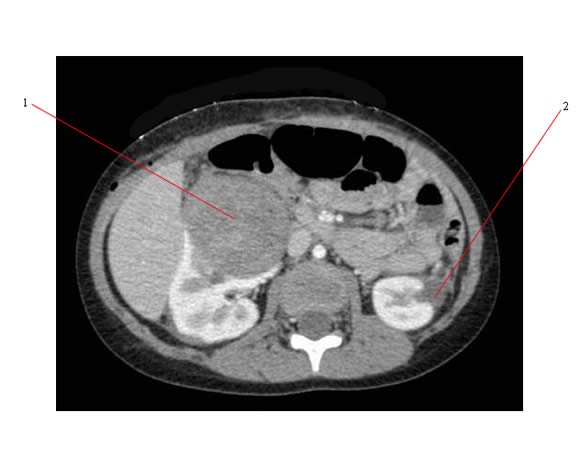Bilateral tumors are associated with an increased incidence of congenital abnormalities. The majority of these patients are less than 1 year old.
The accounts for roughy 5% of patients at presentation.
Bilateral tumors tend to have an indolent course and be FH.
Treatment must be individualized in an attempt to preserve as much normal renal parenchyma as possible.
Most patients present with synchronous disease. They have a prognosis comparable to patients with unilateral tumors. The same factors influence survival with bilateral and unilateral tumors, these being the stage of the tumor and their histology.
Metachronous disease presentations have an ominous prognosis.
The CT below shows a large right sided Wilms tumor (#1) and a much smaller left sided Wilms tumor (#2) in a boy who was under 1 year at the time of presentation.

Therapy of Bilateral WT:
- Previously patients underwent bilateral renal biopsies with staging of each kidney.
- There is often one kidney with virtually no salvageable renal substance while the opposite side has multiple cortical lesions. In this instance the very advanced disease is resected, chemotherapy given and then there is second look surgery to pick out nodules involving the remaining renal cortex.
- However, when it is possible to potentially salvage both kidneys and to improve outcomes, treatment has changed from an initial surgical approach to preoperative chemotherapy. This is used to shrink the tumor and spare renal parenchyma.
- The first COG trial to focus on bilateral Wilms tumors (COG-AREN0534) reflected the present recommendation to not perform an initial biopsy or laparotomy.
- Primary tumor excision should not be attempted, but patients given up-front pre-operative chemotherapy consisting of vincristine, dactinomycin and doxorubicin for the first 6 to 12 weeks of treatment to optimize tumour shrinkage and the potential for nephron-sparing surgery.

